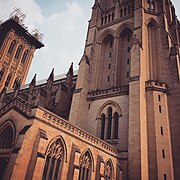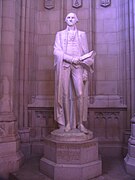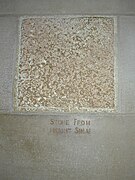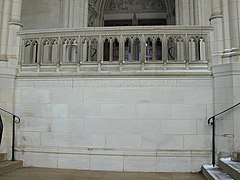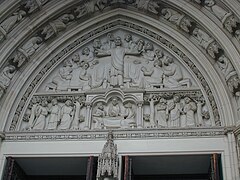
Washington National Cathedral
The Cathedral Church of Saint Peter and Saint Paul in the City and Diocese of Washington, commonly known as Washington National Cathedral or National Cathedral, is an American cathedral of the Episcopal Church. The cathedral is located in Washington, D.C., the capital of the United States.[1][2] The structure is of Neo-Gothic design closely modeled on English Gothic style of the late fourteenth century. It is the second-largest church building in the United States,[3] and the third-tallest building in Washington, D.C. The cathedral is the seat of both the Presiding Bishop of the Episcopal Church, Michael Bruce Curry, and the bishop of the Diocese of Washington, Mariann Edgar Budde. Over 270,000 people visit the structure annually.[4]
"National Cathedral" redirects here. For the national cathedral of the Philippine Independent Church, see Iglesia Filipina Independiente National Cathedral.Location
Wisconsin Avenue and Massachusetts Avenue, Northwest, Washington, D.C., United States
1906 to
1988
May 3, 1974
The Protestant Episcopal Cathedral Foundation, under the first seven Bishops of Washington, erected the cathedral under a charter passed by the United States Congress on January 6, 1893.[5] Construction began on September 29, 1907, when the foundation stone was laid in the presence of President Theodore Roosevelt and a crowd of more than 20,000, and ended 83 years later when the "final finial" was placed in the presence of President George H. W. Bush in 1990. Decorative and restorative work, particularly of damage from a nearby earthquake in 2011, is ongoing as of 2024. The Foundation is the legal entity of which all institutions on the Cathedral Close are a part; its corporate staff provides services for the institutions to help enable their missions, conducts work of the Foundation itself that is not done by the other entities, and serves as staff for the board of trustees.
The cathedral stands at Massachusetts and Wisconsin Avenues in the northwest quadrant of Washington. It is an associate member of the recently organized inter-denominational Washington Theological Consortium.[6] It is listed on the National Register of Historic Places. In 2007, it was ranked third on the List of America's Favorite Architecture by the American Institute of Architects.[7]
Financial concerns[edit]
In January 2003, Nathan D. Baxter, dean of the cathedral, announced his retirement effective from June 30, 2003. Baxter had led the cathedral since 1991.[38] After an 18-month search, Samuel T. Lloyd III was named dean and began his tenure on April 23, 2005.[39] Using a $15 million bequest the cathedral received in 2000, Lloyd rapidly expanded the cathedral's programming.[40][25] Meanwhile, the cathedral deferred maintenance and declined to make needed repairs.[25] Construction also began in summer 2005 on a $34 million, four-level, 430-car underground parking garage. It opened in 2007.[41][25] The structure was pushed by John Bryson Chane, bishop of the Episcopal Diocese of Washington, and was mostly funded by debt. Payments on the garage were $500,000 per year, with a major increase in the annual debt service beginning in 2017.[42] In early 2008, the National Cathedral Association, the church's fundraising donor network, was disbanded after cathedral leaders concluded that the building was "finished" and it was no longer necessary to raise significant funds for construction.[25][43]
The 2008–2009 Great Recession hit the cathedral hard. By June 2010, the cathedral cut its budget from $27 million to $13 million, outsourced the operation of its gift shop, shut its greenhouse, cancelled its plans to replace the Skinner organ in the sanctuary, and ceased operation of the College of Preachers that had provided Episcopal clergy nationwide with continuing theological education. The cathedral also laid off 100 of its 170 staff members, including its art conservator and its liturgist (who researched and advocated the use of liturgies at the cathedral).[44] It also significantly cut back on programming, music performances, and classes.[45] To help stabilize its finances, the cathedral began an $11 million fundraising campaign and used $2.5 million of its $50 million endowment to plug budget holes.[44] The National Cathedral Association was recreated as well.[42]
In June 2010, the cathedral announced that it was exploring the sale of its rare book collection, the value of which was estimated to be several million dollars.[44] It sold a number of books to a private collector in 2011 for $857,000[25] and in 2013 donated most of the remaining collection to Virginia Theological Seminary.[25][46]
As the economic downturn continued, a report by cathedral staff identified $30 million in needed maintenance and repairs.[25] Among the problems were cracked and missing mortar in the oldest sections of the building; broken HVAC, mechanical, and plumbing systems throughout the structure; extensive preservation needs; and a main organ in disrepair. Repointing the building was estimated to cost at least $5 million, while organ repair was set at $15 million.[42]
Since 2016, the Cathedral has stabilized its finances, reporting annual operating surpluses in its audited financial statements for the last seven years,[47] and moving forward with some large capital projects including the renovation and opening of the Virginia Mae Center,[48] commencement of the great organ renovation,[49] and continued earthquake repairs.
Several notable American citizens are buried in Washington National Cathedral and its columbarium:[64]
There are three private Episcopal schools on the grounds of Washington National Cathedral.
In popular culture[edit]
The cathedral played a major role in The West Wing season 2 finale "Two Cathedrals." In a scene following the funeral of a major character, President Bartlet engages in a one-sided argument with God which seamlessly blends English and Latin dialogue.[67] The cathedral also makes appearances in the following movies: The Pelican Brief (1993), Lady-like (2017), and the short documentary The Stone Carvers (1984), which describes the construction of the cathedral.








